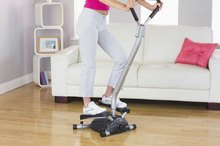Is Walking a Good Exercise for Lower Back Pain?
Lower back pain is the most common work-related disability. Most instances disappear after a few days -- if your pain lasts for more than three months, it's considered chronic. Low-impact exercises, especially walking, are appropriate activities if you suffer from recurring lower back pain. Accompany walking with exercises designed specifically to improve your back strength and flexibility, which your doctor can recommend.
Benefits
Walking strengthens your bones and muscles, including those in your feet, legs, hips and torso along with the back muscles that hold you upright. Stretching and then walking will improve your back's flexibility, range of motion and posture, which can help prevent future back pain or reduce its severity. Walking also stimulates the release of endorphins, which reduce back pain. Incorporating walking into your routine helps improve your spine's stability. This exercise benefits your circulation, helping pump nutrients into tissue and drain toxins, which nourishes your spine.
- Walking strengthens your bones and muscles, including those in your feet, legs, hips and torso along with the back muscles that hold you upright.
- Stretching and then walking will improve your back's flexibility, range of motion and posture, which can help prevent future back pain or reduce its severity.
Safety
How to Lose Weight With Lumbar Spinal Stenosis
Learn More
If you suffer from lower back pain, you may find many types of exercise injure your back, especially high-impact activities such as jogging. Walking is less intense than many other forms of exercise and thus less likely to aggravate your condition.
You might experience some discomfort from walking. If it causes pain, try a different low-impact activity such as swimming, riding a stationary bicycle or yoga. Only walk on flat surfaces during healing to prevent straining your back.
- If you suffer from lower back pain, you may find many types of exercise injure your back, especially high-impact activities such as jogging.
Technique
When you walk, keep up a rapid pace but do not exercise to the point of breathlessness. You should be able to carry on a conversation without gasping for air. Begin with a slow five-minute walk and continue until you're walking for at least 30 minutes, or 2 miles, three or four times a week. Maintain correct posture to prevent further injury to your back -- use the abdominal muscles to support your trunk and spine by keeping your stomach tucked in slightly and standing completely upright. Don't lean forward when you walk. Swing your arms and keep your hands relaxed. If you're on a treadmill, avoid using the handrails unless you need them to keep your balance.
- When you walk, keep up a rapid pace but do not exercise to the point of breathlessness.
- If you're on a treadmill, avoid using the handrails unless you need them to keep your balance.
Other Factors
Does Walking Help You Lose the Fat Around Your Waist?
Learn More
Make sure you stretch before exercising. Use gentle stretching techniques to stretch your neck, arms, hips, legs, hamstrings and ankles. Purchase walking shoes that fit correctly. Your feet keep your body aligned and in balance -- ill-fitting shoes can lead to bad posture, muscle strain and back pain.
- Make sure you stretch before exercising.
Related Articles
References
- Spine-Health; Exercise Walking for Better Back Health; Ted Forcum, Thomas Hyde
- Steffens D, Maher CG, Pereira LSM, et al. Prevention of low back pain. A systematic review and meta-analysis. JAMA Intern Med. 2016;176(2):199-208. doi:10.1001/jamainternmed.2015.7431
- Koes BW, van Tulder M, Lin CW, Macedo LG, McAuley J, Maher C. An updated overview of clinical guidelines for the management of non-specific low back pain in primary care. Eur Spine J. 2010;19(12):2075-2094. doi:10.1007/s00586-010-1502-y
- American Academy of Orthopaedic Surgeons. Low-back surgery exercise guide. Updated January 2017.
- Shnayderman I, Katz-Leurer M. An aerobic walking programme versus muscle strengthening programme for chronic low back pain: A randomized controlled trial. Clin Rehabil. 2013;27(3):207-14. doi:10.1177/0269215512453353
- Kim H, Min TJ, Kang SH, Kim DK, Seo KM, Lee SY. Association between walking and low back pain in the Korean population: A cross-sectional study. Ann Rehabil Med. 2017;41(5):786-792. doi:10.5535/arm.2017.41.5.786
Writer Bio
Jen Morel has worked in the newspaper industry since 2007. An experienced backpacker, she is a contributor to "AMC Outdoors" and other hiking/environmental magazines. She holds a Bachelor of Arts in cognitive science and philosophy.









